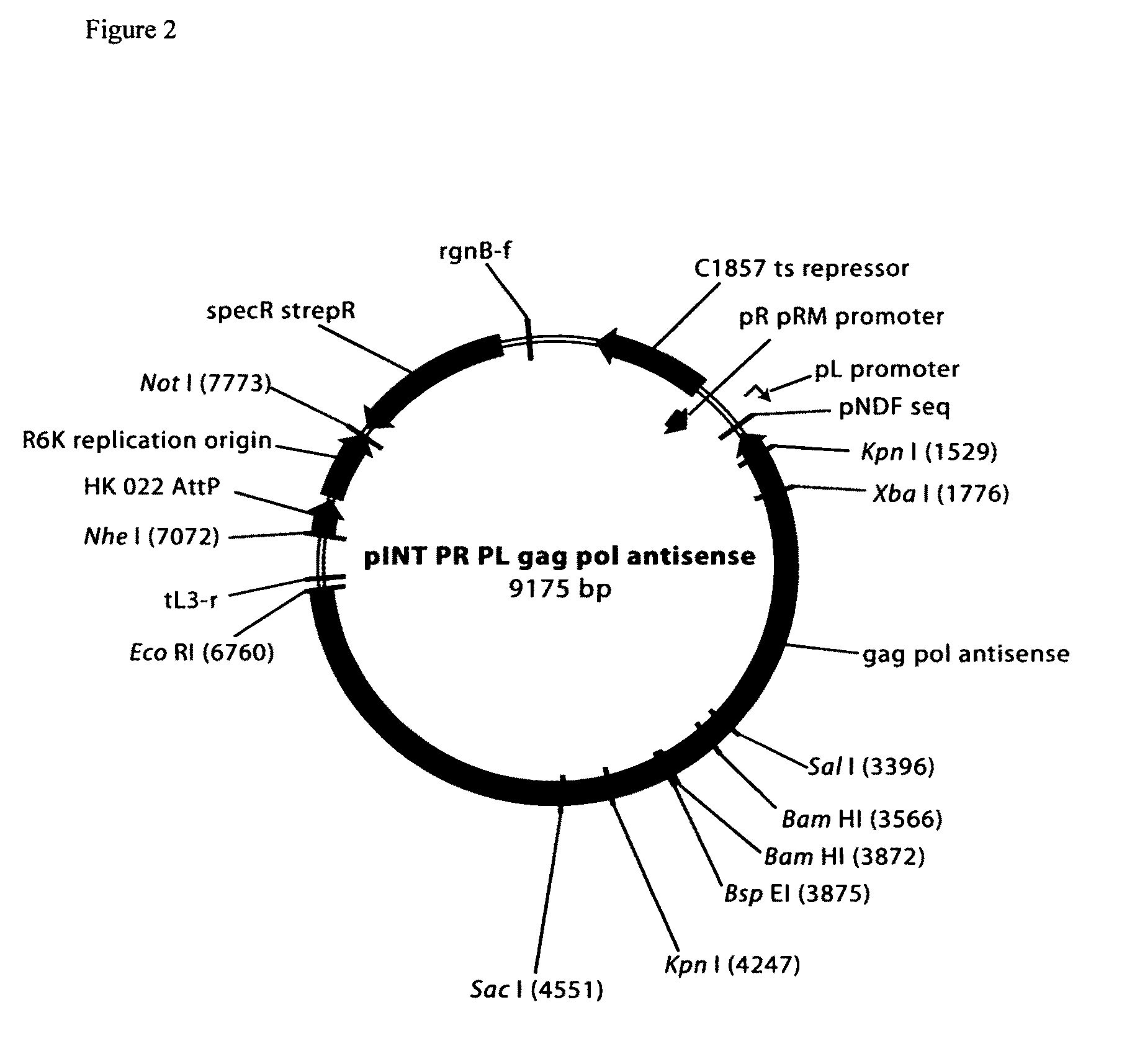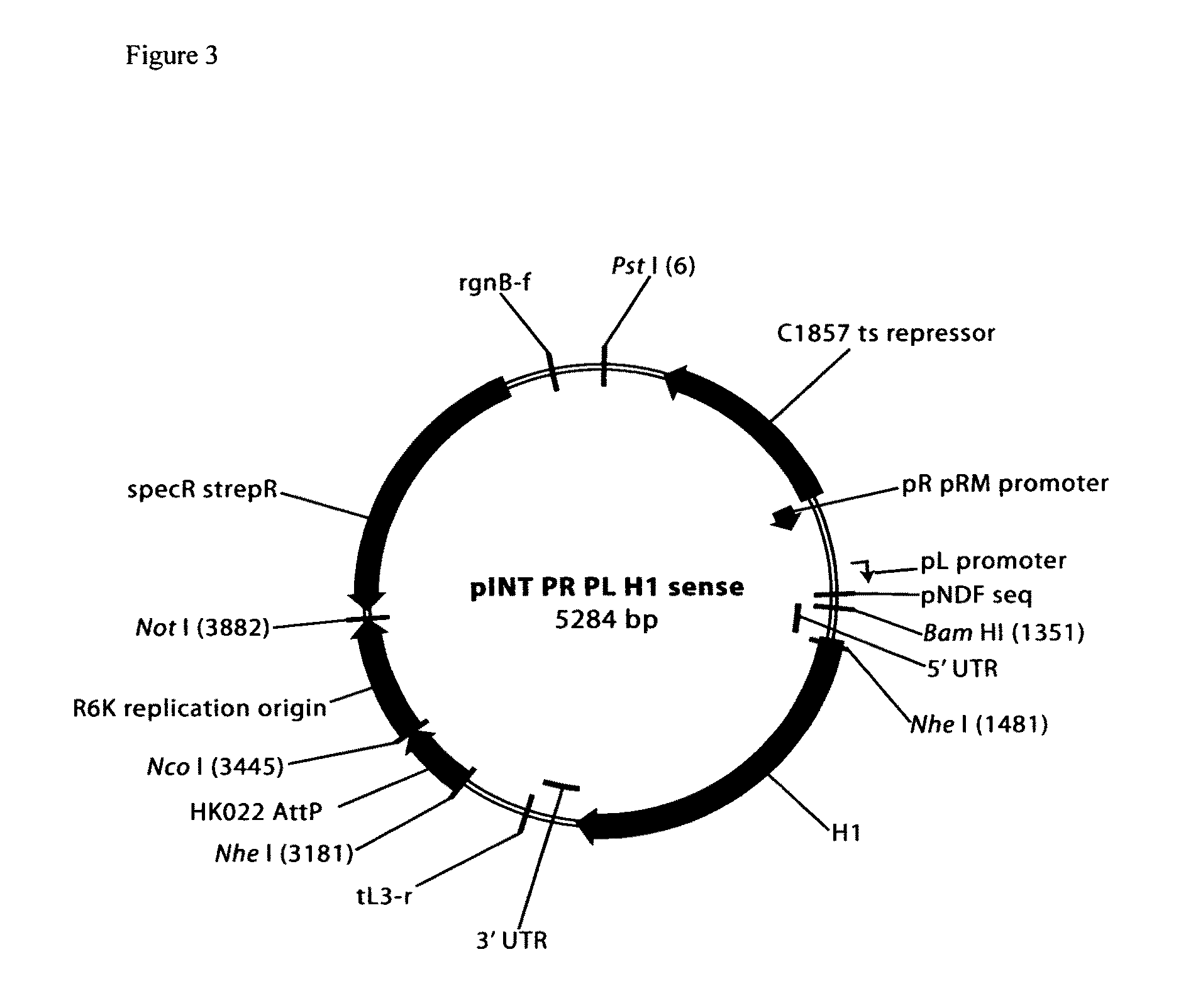Bacterial strains with improved plasmid stability
a technology of plasmid stability and bacteria, which is applied in the field of bacteria strains with improved plasmid stability, can solve the problems of affecting the expression of toxic peptides encoded by the antisense strand, and requiring vector modification to insert the promoter, so as to improve the copy number of vectors and increase production yield
- Summary
- Abstract
- Description
- Claims
- Application Information
AI Technical Summary
Benefits of technology
Problems solved by technology
Method used
Image
Examples
example 1
Development of Vectors Expressing Anti-Insert RNA
[0059]A number of vectors contain insert sequences that dramatically reduce vector yield and stability for unknown reasons. The inserts from two poor producing plasmid vectors (pMLV gag pol, and NTC7382 41H H1 HA) were cloned into an RNA expression vector as described below.
pINT PR PL vector
[0060]The pINT PR PL vector is a replication incompetent plasmid that may be site specifically integrated into the genome at the HK022 bacteriophage attachment site utilizing HK022 bacteriophage recombinase-expressing plasmid pAH69 (Haldimann A, Wanner B L. 2001. J Bacteriol. 183: 6384-6393). The pINT PR PL plasmid is a derivative of pAH144 (Haldimann and Wanner, Supra, 2001). The pAH144 plasmid contains the R6K conditional replication origin and requires an engineered pir+host cell strain such as BW23474 for propagation. This origin is non functional in most strains including DH5α. The vector also contains a multiple cloning site, a streptomycinR ...
example 2
Creation and Evaluation of Cell Lines Expressing Anti-Insert RNA
[0066]Cell lines were constructed with a single copy of the insert containing RNA expression vector integrated into the genome. The poor producing plasmid was then transformed into the RNA expression vector cell line and plasmid yield from the modified cell line, compared to the parent cell line, assessed in fermentation culture.
[0067]Manufacturing cell lines: Fermentations were performed with E. coli strain DH5α [F−Φ80d / acZΔM15 Δ(lacZYA-argF) U169 recA1 endA1 hsdR17(rk−, mk+) phoA supE44 λ-thi-1 gyrA96 recA1] or DH5α−pINT PR PL H1 sense or DH5α−pINT PR PL gag pol antisense. The latter two cell lines contain a single copy of the indicated pINT PR PL plasmid integrated into the genome at the HK022 bacteriophage attachment site utilizing HK022 bacteriophage recombinase-expressing plasmid pAH69, and single copy integrants confirmed with PCR using P1-P4 primers as described (Haldimann and Wanner Supra. 2001). The helper pla...
example 3
Host Strain Producing Antisense RNA Complementary to the MuLV Gag Pol Gene Insert Improved Toxic Plasmid pMLV Gag Pol Yield
[0070]Triplicate fermentations of the DH5α antisense (DH5α−pINT PR PL gag pol antisense) pMLV gag pol cell line at 30° C. constant temperature resulted in very high plasmid specific yield (5.0 to 6.7 specific yields at harvest; Table 1). A fermentation of the control DH5α:pMLV gag pol strain at 30° C. constant temperature had much lower copy number (0.9 specific yield at harvest; Table 1) than the antisense strain. This demonstrates the surprising benefit of the antisense host strain for production of this plasmid even under these conditions (30° C.) wherein only low levels of RNA are produced from the temperature inducible λpR-λpL promoters.
[0071]
TABLE 130° C. constant temperature 10 L fed-batch fermentations withpMLV gag pol vectorSpecific plasmidOverall plasmidyield (mg / L / OD600)Strainyield (mg / L)EarlyHarvestDH5α1053.5@22 hr0.9(172 at 37 hr)2.2@35 hr2.1@37 hrD...
PUM
| Property | Measurement | Unit |
|---|---|---|
| constant temperature | aaaaa | aaaaa |
| temperature | aaaaa | aaaaa |
| concentration | aaaaa | aaaaa |
Abstract
Description
Claims
Application Information
 Login to View More
Login to View More - R&D
- Intellectual Property
- Life Sciences
- Materials
- Tech Scout
- Unparalleled Data Quality
- Higher Quality Content
- 60% Fewer Hallucinations
Browse by: Latest US Patents, China's latest patents, Technical Efficacy Thesaurus, Application Domain, Technology Topic, Popular Technical Reports.
© 2025 PatSnap. All rights reserved.Legal|Privacy policy|Modern Slavery Act Transparency Statement|Sitemap|About US| Contact US: help@patsnap.com



